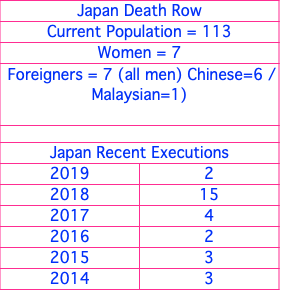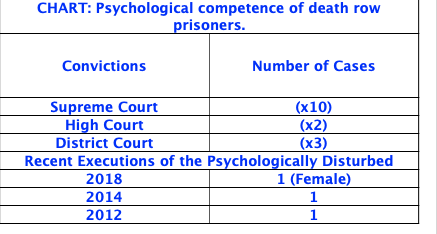The Death Penalty in Japan: 2019
Year End Report Submitted to the
Anti-Death Penalty Asian Network (ADPAN)
Compiled by Michael H. Fox

Japan Innocence and Death Penalty Information Center
www.jiadep.org
jiadep.org@gmail.com
From the Heisei to the Reiwa Era
In 1989, Japan began a new era. With the death of Emperor Hirohito, his son Prince Akihito ascended the throne. The new era was called 'Heisei' composed of two characters associated with 'peace' "平" and, 'becoming' "成"。
It seems the name of the era was taken seriously- no executions occurred for 3 years. At the time, there was talk that Japan might already be abolitionist.
This year, a new emperor ascended and the era has been renamed: "Reiwa." The name is composed of two characters which mean order "令" and harmony "和."
I was shocked. Harmony in Japanese culture is the sum of obedience + conformity. Moreover, the era period rhymes with Showa, the period of Hirohito, 1923~1989, which the right wing looks back upon with nostalgia.
The Reiwa era began on May 1, 2019. Many of us hoped that an entire year might pass without executions. And with Japan hosting the summer olympic games in 2020, perhaps we might even see a second execution-free year?
Hope soon came to nought. Two prisoners were executed on August 2, just 91days after the turn of the era. Indeed this was an explicit gesture that liberal and progressive ideas are a thing of the past. Strict conformity and stringent social policy are the new dicta.
~~~~~~~~~~~~~~~~~

Focus: Execution of the Mentally Ill
Currently 15 prisoners under sentence of death have credible claims of mental illness. According to the Criminal Code (Article 39)
(1) An act of insanity is not punishable.
(2) Those of "diminished capacity" are to receive a lesser punishment.
At the very least, this means something less than the strictest punishment: execution.
Needless to say, these laws are hopelessly ignored. Currently,10 death row prisoners have verifiable psychiatric disorders. One suffers from Minamata disease and can safely be regarded as mentally retarded. One of the 15 executed in 2018 was either mentally diminished or more likely, insane.
Full chart available at http://127.0.0.1:53349/resources/Chart-Mentally-Disabled-Defendants.htmlInto the Future
The abolition movement in Japan is vibrant but very small. The large amount of executions-15-in 2018 was to sweep away those responsible for murders committed by a former religious cult, which among other crimes, released deadly gas in Tokyo subways in 1995. I do not expect Japan to welcome abolition anytime in the near future. At best, we might return to a period of limited executions, 2-3 a year, as has been the case in the recent past.


